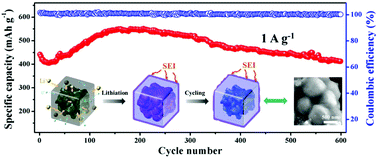当前位置:
X-MOL 学术
›
Inorg. Chem. Front.
›
论文详情
Our official English website, www.x-mol.net, welcomes your feedback! (Note: you will need to create a separate account there.)
Tailoring yolk–shell FeP@carbon nanoboxes with engineered void space for pseudocapacitance-boosted lithium storage†
Inorganic Chemistry Frontiers ( IF 7 ) Pub Date : 2018-09-04 00:00:00 , DOI: 10.1039/c8qi00849c Qiong Wang 1, 2, 3, 4 , Boya Wang 2, 3, 4, 5 , Zhi Zhang 6, 7, 8, 9, 10 , Yin Zhang 1, 2, 3, 4 , Jing Peng 1, 2, 3, 4 , Yun Zhang 2, 3, 4, 5 , Hao Wu 1, 2, 3, 4
Inorganic Chemistry Frontiers ( IF 7 ) Pub Date : 2018-09-04 00:00:00 , DOI: 10.1039/c8qi00849c Qiong Wang 1, 2, 3, 4 , Boya Wang 2, 3, 4, 5 , Zhi Zhang 6, 7, 8, 9, 10 , Yin Zhang 1, 2, 3, 4 , Jing Peng 1, 2, 3, 4 , Yun Zhang 2, 3, 4, 5 , Hao Wu 1, 2, 3, 4
Affiliation

|
As one kind of promising high-capacity anode material for lithium ion batteries (LIBs), iron phosphide (FeP) has recently attracted much attention owing to its high theoretical capacity. However, the FeP anode materials also suffer from the common problems of intrinsically poor electrical conductivity and drastic volume expansion. Here, we design and construct yolk–shell FeP@carbon (FeP@C) nanobox composites with void space by an efficient synthetic strategy of combining etching-in-boxes with phosphidation-in-boxes approach. Rational void space is engineered between the FeP cores and carbon shells in the yolk–shell structure, which offers a buffer zone for adapting the volume expansion of FeP core particles without breaking the protective carbon shells upon lithiation. Benefiting from their unique structural advantages, the as-built FeP@C nanoboxes manifest a superb rate capability with high specific capacities of 495.9 and 220.8 mA h g−1 at 1.0 and 10.0 A g−1, respectively. Quantitative kinetic analysis identifies that the high-rate performance mainly stems from the pseudocapacitance-boosted lithium storage contribution rendered by the yolk–shell nanobox structure. Moreover, the engineered void space in the FeP@C yolk–shell nanostructure also endows it with an excellent long-term and durable cycling stability (93.7% capacity retention after 600 cycles at 1.0 A g−1). This work sheds light on the rational design of nanostructured metal-phosphide-based anode materials for high performance LIBs.
中文翻译:

定制具有工程空隙空间的蛋黄壳FeP @碳纳米盒,用于伪电容增强的锂存储†
作为锂离子电池(LIBs)的一种有前途的高容量负极材料,磷化铁(FeP)由于其高的理论容量而引起了人们的广泛关注。然而,FeP阳极材料还遭受固有的固有的差的电导率和急剧的体积膨胀的问题。在这里,我们通过结合盒内蚀刻和盒内磷化方法的有效合成策略,设计和构建具有空隙空间的蛋黄壳FeP @碳(FeP @ C)纳米盒复合材料。在卵黄-壳结构的FeP核和碳壳之间设计了合理的空隙空间,它提供了一个缓冲区域,用于适应FeP核颗粒的体积膨胀,而不会在锂化过程中破坏保护性碳壳。得益于其独特的结构优势,-1在1.0和10.0 A g -1。定量动力学分析表明,高效率的性能主要源于卵壳纳米盒结构对拟电容增强的锂存储的贡献。此外,FeP @ C卵黄壳纳米结构中的工程空隙空间还赋予其出色的长期和持久循环稳定性(在1.0 A g -1下进行600次循环后,容量保持率为93.7%)。这项工作为高性能LIB的纳米结构基于金属磷化物的阳极材料的合理设计提供了启示。
更新日期:2018-09-04
中文翻译:

定制具有工程空隙空间的蛋黄壳FeP @碳纳米盒,用于伪电容增强的锂存储†
作为锂离子电池(LIBs)的一种有前途的高容量负极材料,磷化铁(FeP)由于其高的理论容量而引起了人们的广泛关注。然而,FeP阳极材料还遭受固有的固有的差的电导率和急剧的体积膨胀的问题。在这里,我们通过结合盒内蚀刻和盒内磷化方法的有效合成策略,设计和构建具有空隙空间的蛋黄壳FeP @碳(FeP @ C)纳米盒复合材料。在卵黄-壳结构的FeP核和碳壳之间设计了合理的空隙空间,它提供了一个缓冲区域,用于适应FeP核颗粒的体积膨胀,而不会在锂化过程中破坏保护性碳壳。得益于其独特的结构优势,-1在1.0和10.0 A g -1。定量动力学分析表明,高效率的性能主要源于卵壳纳米盒结构对拟电容增强的锂存储的贡献。此外,FeP @ C卵黄壳纳米结构中的工程空隙空间还赋予其出色的长期和持久循环稳定性(在1.0 A g -1下进行600次循环后,容量保持率为93.7%)。这项工作为高性能LIB的纳米结构基于金属磷化物的阳极材料的合理设计提供了启示。



























 京公网安备 11010802027423号
京公网安备 11010802027423号